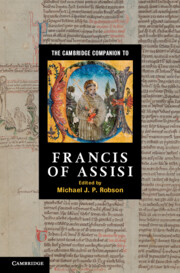Book contents
- Frontmatter
- Introduction
- PART I Francis of Assisi
- PART II The heritage of Francis of Assisi
- 10 Francis and the pursuit of learning
- 11 The early Franciscans and the towns and cities
- 12 The Third Order of Francis
- 13 Franciscan ideals and the royal family of France (1226–1328)
- 14 Franciscans as papal and royal envoys to the Tartars (1245–1255)
- 15 Franciscan missions
- 16 Pope John XXII, the Franciscan order and its Rule
- 17 The ecumenical appeal of Francis
- A guide to further reading
- Index
12 - The Third Order of Francis
from PART II - The heritage of Francis of Assisi
Published online by Cambridge University Press: 28 November 2011
- Frontmatter
- Introduction
- PART I Francis of Assisi
- PART II The heritage of Francis of Assisi
- 10 Francis and the pursuit of learning
- 11 The early Franciscans and the towns and cities
- 12 The Third Order of Francis
- 13 Franciscan ideals and the royal family of France (1226–1328)
- 14 Franciscans as papal and royal envoys to the Tartars (1245–1255)
- 15 Franciscan missions
- 16 Pope John XXII, the Franciscan order and its Rule
- 17 The ecumenical appeal of Francis
- A guide to further reading
- Index
Summary
The Third Order of St Francis developed from the lay penitential movement of the Middle Ages. As literacy spread and the religious needs of the faithful shifted, the general population began to seek ways to live the Gospel with greater intensity. These laity became known as penitents, because they had undergone dramatic conversion experiences. The way of penance was understood in the biblical sense as metánoia, a reversal of values and behaviour. In his Testament, Francis describes his life in terms of such a reversal: his earlier ‘life in sin’ among the townspeople of Assisi and his later ‘life of penance’. Penance was not about asceticismor repentance within the sacramental system; instead, it meant imitation of the way of the apostles, who shared their goods and identified with the poor Christ by caring for those in need.
When Francis ‘left the world’, he abandoned his reliance on the values subscribed to by society within the flourishing urban centres. While about 90 per cent of the people lived at or below subsistence level, the rising merchant class was beginning to challenge the dominance of the landholders. This world of accumulated wealth, ownership, power and prestige is the world Francis left. Instead, he sought an alternative world in a social system rooted in the Gospel and its concern for each person, especially the poor and outcast. Francis's efforts were reinforced by Assisi's Freedom Charter of 1210, which shifted power from the nobility back to the common folk.
- Type
- Chapter
- Information
- The Cambridge Companion to Francis of Assisi , pp. 193 - 207Publisher: Cambridge University PressPrint publication year: 2011



